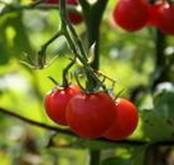| Kingdom | Plantae |
| Unranked | Angiosperms |
| Unranked | Eudicots |
| Order | Solanales |
| Family | Solanaceae |
| Genus | Solanum |
| Species | S. lycopersicum |
| Binomial name | Solanum lycopersicum |
Other Common Names:
The other common names for the tomato are Fan Shih, Garden Tomato, Liu Yueh Shih, Love Apple, Pomme D'Amour, Pomodoro, Tamata, Tomaat, Tomate and Tomatero.
History
The common German name for tomatoes translates to "wolf peach", and because of this it was universally avoided. In the 18th century the tomato species was named Lycopersicon esculentum, which literally means, "edible wolf peach". The name of tomatoes "love apple" has not originated in connection with aphrodisiacs but by mistake in translation. The original name was "mala cethopica" i.e. carrot apple.

Description


Range
The tomato is native to Central and South America and is now cultivated through out the world.
Habitat
The plant prefers light sandy, medium loamy and heavy clay soils and requires well-drained soil. The plant prefers acid, neutral and basic alkaline soils. It cannot grow in the shade. It requires moist soil. It is generally seen in cultivated beds.
Cultivation
Tomatoes do not tolerate freezing temperatures, so it is best to plant them once the weather is warm. For adequate harvest room, you will need to space your plants apart. The spacing for each variety is different, however. For dwarf plants, they will need to be twelve inches apart in the row. Staked plants will need to be 15 to 24 inches apart. Some indeterminate varieties even need four feet of space between them in the rows and five to six feet in between rows. When you plant your tomato plants, you should fertilize them right away. You can also cultivate shallowly or hoe to keep the weeds down without doing damage to the roots. Mulching is highly recommended, especially if you want to have your plant for the full season harvest. Organic materials or black plastic is okay to use for mulching. However, don't put down organic materials until the soil has warmed up all the way. If you put it down too early, the plant will not grow very well. You will need to water your tomato plants regularly and thoroughly. If you are keeping your plants in containers they may need to be watered every day or even more. You will also need to feed your plants with a liquid tomato fertilizer once every two to three weeks until the end of August. The fertilizer should be high in potash. Once September arrives, just feed it with a regular fertilizer that is high in nitrogen. Weed around the plants as much as you can to prevent bugs and diseases from getting to your tomatoes. As the plant grows, you will also need to use stakes to support it. Tie the main stem to the stakes.
Parts Used

Only the fruit of tomato is used for its commercial and medicinal applications.
Flowering Season
The yellow flowers of the tomato are hermaphrodites and are in bloom from June to September.
Pests and Diseases
One common tomato disease is tobacco mosaic virus, and for this reason smoking or use of tobacco products are discouraged around tomatoes, although there is some scientific debate over whether the virus could possibly survive being burned and converted into smoke. Various forms of mildew and blight are also common tomato afflictions. Another particularly dreaded disease is curly top, carried by the beet leafhopper, which interrupts the lifecycle, ruining a nightshade plant as a crop. Some common tomato pests are cutworms, tomato hornworms and tobacco hornworms, aphids, cabbage loppers, whiteflies, tomato fruitworms, flea beetles, red spider mite, slugs and Colorado potato beetles.
Medicinal Applications


• Tomatoes are very beneficial for cardiovascular diseases.
• They improve blood formation, haemoglobin formation, and increase immunity.
• Antibiotic effects are recognised.
• They improve digestion, peristaltics.
• Recommended for viroses and contagious diseases.
• Tomatoes are suitable with jaundices and liver fat degeneration, pancreatitis and disorders of substance transformation.
• They have anti-sclerotic effects, improve the condition of blood-vessels and capillaries, cure haemorrhoids, varices and cracked veins.
• They dissolve accumulated waste acids, therefore they are suited for gout and rheumatism.
• Tomatoes improve the function of kidneys and urine secretion.
• Tomatoes protect against lunge cancer. Tomatoes contain a large amount of beta-carotene that is assumed to be the most effective anti-cancer substance contained in vegetables.
Commercial Applications


• The strong aroma of this plant is said to repel insects from nearby plants.
• Tomato is used both raw and cooked and in salads.
• Semi-drying oil is obtained from the seed which can be used in making soap.
• A spray made from tomato leaves is an effective but very poisonous insecticide.
• It is especially effective against ants but should be used with great caution because it will also kill beneficial insects and, if ingested, is toxic to humans.
• The pulp of the fruit is used cosmetically in face-packs.

The annual La Tomatina festival, regularly held in a town of Bunol, nearby Valencia, became famous due to the celebration of the village's patron, Saint Louis, lasting one week. In 2002, 38,000 persons spent 1 hour in a "battle"where they got through 120 tonnes of tomatoes. This tradition repeats itself each year, and nobody knows how this custom was originated.
Despite its association with Witches and the Black Arts, early efforts to peddle the tomato were not highly successful. Even in one of America's towns most associated with Witchcraft - the hamlet of Salem, Massachusetts a painter hoping to make a little extra money selling the fruit had difficulty even convincing people to taste the red fruit. The Tomato was known to be popular in various southern parts of the continent but was not recommended by the French Aristocracy, making it the perfect mascot for the blood thirsty hordes.
It quickly became the fruit of choice to the Republican masses and came to be served as stewed side dishes and as summer salads. Superstition once had it that placing ripe tomatoes on a mantel when first entering a new dwelling would guarantee future prosperity or will ward off evil spirits Pincushions the colour and shape of ripe tomatoes were used instead if ripe tomatoes were not available.